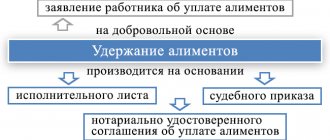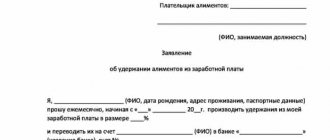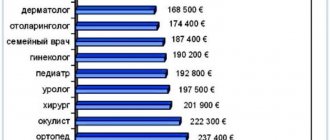Author of the article: Dmitry Lidov If you need free legal advice
, click here
The issue regarding the amount of alimony and its payment in general is a pressing issue for Russian society. Since there is no clearly defined amount that would fully meet the child’s needs. At the same time, each parent takes into account only his own interests, with absolutely no interest in the needs of others.
Any citizen faced with this problem knows that the amount of the withheld amount from the salary in favor of the child will be calculated as a percentage of its official volumes, which are often insignificant.
All this makes it possible for many payers to avoid large deductions for alimony. After all, it is possible to receive part of your salary in an envelope or use other tricks to reduce financial losses.
Recipients of funds whose children are retained in this case face many difficulties, since they have to resolve all financial issues on their own.
In such a situation, both parties are faced with the pressing issue regarding the maximum percentage of alimony withholding from wages, the decision of which entirely depends on the legislator.
The legislative framework
To calculate alimony, Chapter 16 of the RF IC is used. This section of the legislation talks about the methods, amounts and logic of assigning payments.
There are 4 methods for calculating alimony:
- share;
- fixed;
- natural;
- property.
What is the maximum percentage of alimony that can be withheld from your salary? In the Russian Federation, fractional calculation is most often used. This method is convenient when calculating alimony when there are 3 or more children in the family; in this case, the maximum amount is calculated as a percentage (Article 81 of the RF IC). This paragraph of the code talks about the connection between the share of payments and the number of minors who are entitled to payments:
- for one child, 25% of income is withheld from the parent;
- for two - 33%;
- for three or more - 50%.
Important
With shared accrual, the maximum child support is determined immediately. However, even if 50% of the payer’s income is charged, the recipient may not be satisfied.
To distribute alimony, they refer to Article 99 of the Federal Law “On Enforcement Proceedings”, due to which a percentage of the payer’s earnings cannot be freely transferred to third parties. A maximum of 70% of the salary of the alimony obligee can be withheld.
Several writs of execution can be attached to the payer at once. In this case, the amount of payments for each child will be limited.
Amount of payments for several children
Payments of a certain share of earnings in favor of children are provided for in Art. 81 RF IC. This rule establishes a basic, not maximum, amount of alimony. It amounts to:
- 25% of income for one child;
- 1/3 of earnings for 2 children;
- 50% for three children or more.
All children, including those living with the debtor and those born in different marriages, have the right to receive equal payments.
In this case, the court can either reduce the specified payments as a percentage or make them higher if it determines that there are grounds for this. The reasons may be:
- high income of the payer, when the provided share of the salary is sufficient to support minors;
- low earnings, at which the maintenance transferred to three children may exceed 50% or be less than this share;
- If a parent or a loved one has disabilities or health problems, the recovered share often becomes lower.
- cohabitation of the debtor with other dependents.
From what types of earnings is alimony withheld?
Alimony payments are withheld from wages and from any other remuneration. The payer can work in several places, and payments will be withheld from each salary. When employed in several companies, the alimony worker should take several writs of execution to present them to the accounting department of each place of work. Without an executive document, the accounting department will not be able to make calculations.
Collection occurs from earnings received from participation in transactions:
- from commission;
- from payment for work based on a transaction under a civil contract;
- from royalties;
- from the amount of remuneration due to the performer.
For hourly wages:
- from interest received from proceeds;
- from the employee’s official salary or the attached tariff rate;
- from income at piece rates;
- from allowances and additional payments that supplemented the tariff rate or salary (for example, if the payer works in hazardous conditions, temporarily replaced a specialist in the company, or received a payment for long service);
- from bonuses received regularly or periodically.
When paying for labor in kind
If an employee is paid in kind, the withholding becomes equivalent to the market value of the benefits received at the time the employee was paid.
With such additional payments as:
- benefits paid to temporarily disabled citizens;
- Withholding of alimony does not occur from maternity benefits.
From what types of earnings alimony is not withheld?
Alimony is not calculated on the following types of income:
- bonus issued once (one-time);
- severance pay, which is issued upon dismissal;
- material assistance to young parents getting married, victims of natural disasters, fires, thefts, injuries, death of relatives;
- compensation payments when traveling on a business trip or transferring to work in another area;
- compensation for payment of therapeutic and preventive nutrition;
- compensation for a tool that has ceased to function due to wear and tear, belonging to a production employee.
To calculate alimony, only the employee’s actual earnings are used. For example, if the payer takes unpaid leave, the accountant will only be able to take a percentage of the time worked towards alimony. In the same way, monthly payments that can be withheld are calculated before the recipient turns 18 years old. Accrual occurs only for the days that the employee worked before the child turns 18 years old.
If the debtor does not pay
In a situation where child support is a percentage of salary, problems do not arise. A person works, receives official income, from which the required deduction is automatically made. It is simply impossible to avoid payments in such a situation.
Another situation is if the debtor does not work and does not voluntarily pay the amount required by law or by agreement. Then the woman turns to the bailiff, who, using the current average salary to calculate alimony, calculates the amount of the actual debt.
That is, if the father has not paid for six months, then for each month he will be assigned a debt according to the average salary in Russia. As a result, a decent amount can immediately form. How can a bailiff collect a debt in such a situation:
- seize all bank cards and accounts, transfer the funds received to the child’s mother;
- organize the arrest and seizure of valuable property, often in this situation we are talking about a car.
If suddenly the bailiff discovers that the debtor is officially employed, he promptly sends a decree to his place of work, according to which he will no longer withhold the required 25%, but the entire 70%. It is this percentage that bailiffs can impose if there is a debt. So, what percentage of the salary will be alimony depends on the presence of debt. This 70% will be deducted until the debt is eliminated. Next, the standard 25% will be withheld if we are talking about one child.
Maximum amount of alimony by method of collection
The maximum amount of alimony is directly dependent on the method in which it is collected.
- Voluntary recovery by agreement of the parties;
- Compulsory (through the court), working thanks to a writ of execution.
According to the writ of execution
If the parents have not entered into a child support agreement, monetary benefits are awarded through the court. The judicial authority establishes the amount that the alimony provider will pay, assigning it taking into account the financial situation of the payer and the method of collection.
This is also important to know:
How to apply for alimony without divorce (in marriage), documents for alimony
There are three forms of alimony payments:
- fixed, representing a fixed monetary amount;
- shared, charged as a percentage of income;
- mixed.
In the case of using a fixed form of funds collected from a person, the court takes into account the cost of living in force in a given region. If there is no fixed PM in the legislative acts that are used in the area where the child lives, then the court can use the average for the Russian Federation. This indicator is divided into two equal parts, since both parents are equally obliged to support their child.
A maximum limit of alimony can be assigned in the case where the plaintiff asks the court to increase the amount due to serious circumstances, for example, the need for expensive treatment for the child. The judicial authority may well award large payments in this case.
The maximum amount of alimony can be withheld under the following circumstances:
- the child has needs that are not covered by the standard amount of child support payments;
- the health status of the minor;
- the child’s parents are wealthy people;
- the person obligated to pay alimony is solvent;
- high PM in the area where the child is registered.
When considering a child support case, the court will definitely pay attention to:
- whether the payer is officially employed;
- availability of registration of the state of emergency;
- unstable income of the alimony worker;
- the presence of profits received in foreign currency;
- failure to satisfy the child’s needs through penalties from the established portion of the salary.
Fact
According to Article 117 of the Family Code of the Russian Federation, when the cost of living decreases, the amount of alimony does not change.
The maximum percentage that can be collected from the payer is determined by Art. 81 RF IC:
- for one child – 1/4 of the income;
- for two – 1/3;
- for three or more – 1/2.
Percentage division is used in the following cases:
- when the payer receives income monthly;
- the alimony worker’s income is higher than the minimum wage in the Russian Federation;
- when parents cannot come to a mutual agreement.
When applying percentage calculations, the rule is that the higher the income, the greater the alimony payments.
The amount of payments to each of the children does not depend on the number of children, the order of their birth and the marriage between the parents. You can change the amount of payments by going to court; in legal proceedings, the interests of minors will be taken into account first of all.
The maximum limit of charges is 70% (Article 138 of the Labor Code of the Russian Federation). If you ignore legal norms, you should contact the appropriate authorities.
By agreement
An agreement legally drawn up by the child’s parents has legal force. It can be used to collect alimony through the court. The maximum amount of payments in this case is not limited; it will depend only on the capabilities of the alimony obligee. The minimum amount of alimony payments is regulated by Article 81 of the RF IC and is applied if the payer has a permanent income. If the child support provider does not receive regular payments, the amount must correspond to the needs of the child.
When drawing up an agreement, the possibility of changes in PM and average wages is taken into account. If these indicators change, the payment amount will be recalculated.
If changes need to be made to the document, parents follow the rules that were used during the signing process. The agreement cannot be terminated unilaterally. Any change to the terms requires the consent of both parties. When the parties cannot agree, the dispute is resolved through court.
The notary, under whose guidance the document was drawn up, monitors compliance with the requirements of the contract.
Factors influencing the amount of alimony
From all the examples given, it is clear that the maximum amount of alimony in the unchanged version is not determined by the legislator.
Any of the listed methods indicates that the court, in determining the interest rate, takes the official income of the defendant as a basis and calculates a maximum of 50% from it. In the case of a fixed amount, the maximum that the defendant receives per month is also taken into account. This means that in any case, the court is guided by the existing financial circumstances of the defendant and, based on the obtained realities, determines the amount of deductions for the child’s living expenses.
The final amount of payments specified in the court ruling will be determined taking into account all the factors considered at the meeting.
These are the following circumstances:
- Marital status of the parties If a man has already managed to acquire a new family in which there are children or elderly parents remain in his care, the court will take into account these circumstances.
- Health condition The circumstances of the defendant’s life have developed in such a way that he has become disabled and cannot fully fulfill his obligations. Then he has the right to go to court with a request to reduce the amount of payment.
- Change in the level of income of the parties There are several options for the development of events, it all depends on which direction the profitability changes:
- if the father’s income has increased and, according to the existing percentages, contributions in favor of the child are very high, then the court can reduce the interest below the maximum limit established by law;
- in this case, the recipient has the right to challenge such a decision, based on the fact that the child has grown up, he needs to enter a university or other educational institution and the funds contributed by the father are not enough.
- The minor child has his or her own income
For example, the child owns a rental property or receives interest income from the deposit. Then the father has the right to petition the court with a request to review the amount of alimony. But this option also has a downside, since he is obliged to pay the minimum established by law for child support.
The court will consider all of the above cases and many other nuances before determining the amount to be paid to retain the child. When one of the parties applies again, any changes in the life and income of citizens will also be taken into account.
Difficulties in determining the maximum amount of alimony
Free legal consultation We will answer your question in 5 minutes!
Ask a Question
According to the beliefs according to which the Family Code of the Russian Federation was drawn up, only the voluntary participation of parents in the process of supporting children can be the basis for a fair assignment of alimony. Thus, voluntary agreement between parents has a positive effect on the process of assigning payments.
Free legal consultation
We will answer your question in 5 minutes!
Ask a Question
The following problems often arise in life:
- The child support provider avoids fulfilling obligations and strives to pay the child as little as possible.
- The payer is not officially employed or not all of his salary is white.
- The person obligated to pay alimony hides his income from the state.
This is also important to know:
Where to apply for alimony: jurisdiction for alimony claims
To protect the rights of a minor, the court has the right to conduct an investigation to determine the amount of income due to the payer. The following can be used as evidence in this case:
- paper;
- oral and written testimony of witnesses;
- video and audio recordings.
Amount of child support from a working or non-working father
If the father is officially employed, payments are usually assigned in shares of the salary, but the plaintiff has the right to demand alimony in a fixed amount.
In the absence of official work, the court obliges to pay fixed amounts, but a share method may also be prescribed. In the latter case, average earnings in the region will be used.
The advantage of collection as a share of the average salary is the possibility of claiming alimony debt if it accumulates for the payer.
Collection in a fixed amount also has advantages: despite the lack of income, the alimony payer will be required to transfer a certain amount of money monthly.
Conditions affecting the purpose of payment
Due to the fact that maximum payments are not defined at the legislative level, a settlement agreement helps to determine alimony amounts best. Thanks to him, parents will be able to agree on the most suitable conditions that will not prejudice either party.
When considering the issue, the court will take into account not only witness testimony and other evidence, but also the minimum wage and minimum wage for the area where the meeting is taking place.
Fact
If the court cannot determine the amount of the payer’s income, alimony is prescribed in a fixed amount, which is calculated using the minimum wage.
In this case, the amount of alimony is insignificant. In 2020, the minimum wage in Russia was 11,280 rubles. The amount of child support for one child will be: 11,280 / 4 = 2,820 rubles, which can hardly be called the maximum amount.
If the alimony evaders evades payments, start collecting evidence of his income. The court may take measures against such a draft dodger, including criminal prosecution.
If the alimony payer does not officially work
Calculating alimony from wages is the most convenient option, but it often happens that debtors simply do not have an official place of work. Often they are specifically employed without registration, so as not to pay anything. But the state has provided for such a situation and then uses the average salary to calculate alimony.
The average salary in Russia for calculating alimony is used in all regions, and its amount is regularly updated upward. Currently it is 42,000 rubles; accordingly, according to the law, the father will have to pay 10,500 rubles for one child.
Of course, in practice, not many men earn more than 40,000 rubles, so when the average salary is used to calculate alimony, this is extremely unsatisfactory for them. The father may unofficially receive 20,000 rubles, but by law he will still be required to pay the required 10,500 rubles.
How much alimony should I pay as a percentage in 2020?
Monthly child support payments are calculated depending on the number of natural or adopted children who need maintenance.
For one child
For one minor, the parent will have to pay 25% of the income.
Let's look at an example. The salary of the alimony worker is 50 thousand rubles. 1400 rub. - This is a standard deduction for 1 child. Personal income tax = ((50000 - 1400) X13%) = 6318 rubles. Alimony in the amount of 25% is calculated from 43,682 rubles. (50,000 - 6318) and will be equal to 10,920.5 rubles.
In the example considered, the amount received must be paid in the current month. If the child’s parents enter into an agreement, the amount of payments fixed in it may only be greater than the received limit. Also, in some cases, it is possible to reduce it if the salary is not enough to support other minors.
For two children
For two children, the parent will have to pay 33% of the income.
The income of the alimony obligee amounted to 80 thousand rubles. If you have two children, the tax deduction will be 2800 rubles. Personal income tax = ((80,000 - 2800) X13%) = 10,036 rubles. Alimony in the amount of 33% is calculated from 69,964 rubles. (80,000 - 10,036) and will be equal to 23,088.12 rubles.
For three or more children
For three or more children, the parent will have to pay 50% of the income.
For example, if the payer’s salary is 40 thousand rubles. The tax deduction for three children will be 5,800 rubles. (1400+1400+3000). Personal income tax = ((40,000 - 5800) X13%) = 4446 rubles. Alimony in the amount of 50% is calculated from 35,554 rubles. (40,000 - 4446), so the maximum alimony payment will be 17,777 rubles.
It happens that the person obligated for alimony gets married again and from each marriage there are minors who need to be provided for. The amounts of payments in this case are calculated similarly, and the payer can apply to the court with a petition to reduce the amount of payments due to these circumstances.
Funds may also be collected from the alimony obligee if his ex-wife is on parental leave or is caring for a child with disabilities under the age of 18. The amount of recovery on this issue is not established by law, so spouses can resolve this issue independently or through the court (Articles 89, 90 of the RF IC). Typically, the size of these payments is 10-30% of the income of the alimony.
Maximum percentage of salary deduction
If the child's parent refuses to support the child and comply with the court order, a share of the income may be collected from him or her. The maximum deduction of alimony from wages is regulated by the law on enforcement proceedings.
If a notarized agreement has been drawn up, it can be used instead of a writ of execution. The parent living with the child can present the document to the bailiffs, who will help collect the debt forcibly.
This is also important to know:
Additional expenses for a child other than alimony: possible grounds and procedure for receiving them
If there is no agreement, the matter can only be resolved through court.
For wife and children
If there are two children, the ex-wife and minors will receive 33% of the income, and if there are 3 or more children - 50%. The court reserves the opportunity to consider each case individually, so the maximum amount of alimony for the wife and children may vary.
For wife and child
The mother and child have the right to receive 25% of the former spouse’s earnings. This is the maximum percentage of alimony withholding from wages.
Important
If the spouse has unstable earnings, the court sets a fixed amount for payments. Although the court is obliged to take care of the maintenance of the minor, it also has no right to infringe on the rights of the father.
Per child
One child, by court decision, can receive 25% of the income of the child support obligee. When making a decision, the judicial authority will pay attention to the financial situation of both parents. Also, the maximum deduction of alimony from wages is determined taking into account whether the basic needs of the minor are covered.
What does the percentage depend on?
The maximum amount of alimony depends on a number of factors.
- Number of children. The more there are, the larger share of earnings you can withhold.
- Timely payment of alimony payments. If the father or mother has a debt, it must be paid off along with the fulfillment of current obligations.
- The need to pay additional maintenance.
- The presence of an agreement or court document on the basis of which payments are withheld in a fixed amount.
- Financial situation of the debtor.
By the tribunal's decision
If the spouses cannot agree on the amount of payments, the court will help sort it out.
For wife and children
If there are several children in a family, a certain percentage or amount of child support payments is calculated for each of them.
Alimony can be:
- defined as a fixed amount (then it is periodically recalculated taking into account rising prices and changes in wages);
- are represented by a certain share of the income of the alimony provider.
Important
It is allowed to pay alimony one time, which must be specified in the contract. In this case, the payment amount is not limited. Also, the alimony obligee has the right to transfer real estate as alimony payment, appointing the parent living with the child as the owner.
For wife and child
Spouses, according to Art. 89 of the RF IC, must contain each other. That is why, if a woman is pregnant or the baby is not yet 3 years old, the husband is obliged to support both of them (Article 89, Part 2 of the RF IC).
The spouse has the right to receive alimony payments (according to Article 90 of the RF IC) under the following conditions:
- the child is under 3 years of age;
- if the child has a disability, payments continue until the age of 18;
- Group I disability of a minor gives the right to unlimited payments.
The maximum threshold of payments for a spouse is limited only by the terms of the contract; there are no other conditions that it cannot exceed any limit.
Per child
The maximum amount of child support payments is not specified in the legislation, but this amount should not infringe on the rights of the payer. In this case, it is important that the amount of alimony is not less than a certain amount.
Important
Payments of 70% of income are applied only in cases where alimony is forcibly collected by a court decision.
Thus, the maximum amount of alimony in each family when drawing up an agreement is limited only by the parties to the agreement.
Payments of alimony for the maintenance of an ex-wife
Art. 89 of the RF IC provides for cases when a spouse is obliged to support his ex-wife.
- Funds are paid during the pregnancy of a common child and until he reaches 3 years of age.
- A disabled spouse who is in a difficult financial situation has the right to receive maintenance. We are talking about cases where the inability to work manifested itself during marriage or within a year after its dissolution.
- Alimony is due to a wife caring for a common child who has a disability and needs financial support.
According to the current rules, these payments are set at a fixed amount. For this reason, it is impossible to calculate the largest share of the debtor's income that is due to the ex-wife.
In what cases is 70% of alimony awarded?
The maximum child support, namely 70% of earnings, applies when:
- There is arrears in child support payments. The court takes into account the reasons for the accumulation of debt. If the reason is not valid, this maximum threshold may be imposed until the debt is resolved.
- 3 or more children, one of whom has a disability. A child with disabilities requires more resources to ensure a normal life.
If the alimony provider does not agree to pay the maximum amount, he can appeal to the court (Articles 114, 119 of the RF IC). Moreover, if the case is supported by the circumstances stated above, the payer’s demand to reduce the maximum percentage of alimony from the salary will not make sense.
The parent who is responsible for the payments can check their accrual:
- having read the executive documents;
- having studied the accounting documentation if there is a deduction from wages.
If an error is identified when calculating payments, the person who made the calculation is responsible for the refund.
Reducing the amount of payments
If the payer of the maximum alimony has life circumstances in such a way that it is necessary to reduce the amount. He has the right to go to court, but he must have one of the good reasons as an argument and draw up the documents correctly.
Reasons for reducing payments:
- Disability – as a basis, the debtor must have a disability of group 1 or 2, documented, the need for additional expenses for treatment and outside care.
- Profitability – for a child who is entitled to alimony, the presence of an enterprise, an apartment for rent, shares, securities, work activity.
- The payer has dependents in the form of young children, elderly parents or disabled people, a non-working wife and other persons whom he, according to the law, must provide for.
- Children from different women - then each of them claims to receive payments in the amount of 25%, while according to the law, for two children the father must pay a maximum of 33%.
- The father has a very large income - then the payments are so high that he fully provides for the child’s needs and there are funds left over.
- There is a significant decrease in the payer’s income level , and he is unable to pay even the minimum for the child.
How is the amount of child support for one child determined?
To choose an option convenient for both parents, it is better to draw up a bilateral agreement. If it is impossible to do this, you should seek help from the court.
According to the alimony agreement
Free legal consultation We will answer your question in 5 minutes!
Call: 8 800 511-39-66
The document may specify controversial issues of any nature: the frequency and periodicity of communication between the child and the parent who left the family, the responsibilities of the parents, the amount of payments, etc. The agreement must be certified by a notary, who will ensure that the interests of the child are respected.
Free legal consultation
We will answer your question in 5 minutes!
Ask a Question
This is also important to know:
How not to pay alimony for a child or wife: all legal ways to evade obligations
The spouses independently agree on the payment procedure. He can be:
Fixed
The amount agreed to be fixed from income is withheld for a certain period specified in the contract. For example, 10 thousand rubles every month until the 7th of the next month.
The procedure for indexing payments can also be specified, that is, how the amount will increase over time. If the spouses did not take care of this when drawing up the agreement, alimony should still increase in parallel with the growth of the monthly minimum wage in the region.
Let's look at an example:
Vasiliev V.N. has the obligation to pay alimony for the maintenance of his son, who lives in the city of Alexandrov. The monthly payment agreed upon by the child’s parents is 5,000 rubles; indexation was not specified in the agreement. In the second quarter, food prices rose, and the monthly average increased from 9,365 rubles to 9,864 rubles. How much should Vasilyev pay now?
To calculate indexation, we use the formula: (fixed amount of alimony / old PM) × new PM. That is, after indexation, Vasiliev will need to pay: (5,000 / 9,365) × 9,846 = 5,258 rubles.
In shares
The parties have the right to decide independently what percentage of the salary will be alimony payments. The share should not be lower than 25% (1/4 of the income received), this is the amount the child is entitled to by law. Thus, when parents decide, the share may be a larger percentage.
One time
In the case where the person obligated for alimony has expensive property or has a large amount of money at the moment, the child’s parents can agree on a one-time payment. In this case, the notary must check whether it would be beneficial for the child to receive one payment instead of receiving monthly assistance. A lump sum payment is appropriate when a child can receive real estate, a share in a business, or open a bank account, since these incomes will be useful to him in the future.
By court decision
The court may decide on fixed payments or shared payments. Also, the judicial authority can combine these methods of calculating alimony if circumstances so warrant. The court does not have the right to make a “suspensive” decision, according to which the alimony will first pay a fixed amount, and after some time, if certain circumstances arise, he will have to give a share of the income received.
In shares of earnings
Paying the maximum amount of child support for one child is quite simple. By law, one child has the right to receive 25% of the income of the parent who left the family or ¼ share of all earnings received by him. The list of types of income from which alimony payments are collected as a percentage can be found in Decree of the Government of the Russian Federation dated July 18, 1996 N 841.
The fourth part, according to this resolution, is withheld from almost all receipts of the payer. If a child support worker works two jobs, rents out housing, or receives income from farming, the child must receive a percentage of this profit. There are several exceptions when funds for a child are not withheld from income:
- If the payer received financial assistance one-time in connection with one of the following events: the birth of a child, injury, loss of a breadwinner, receipt of maternity capital.
- In the case where the funds were received by the alimony provider to provide for another person. The payer may himself be a recipient of alimony and may be entitled to monthly payments.
- The funds were received as compensation from the employer of the alimony recipient (for transfer to work in another area or business trip).
Alimony payments are also withheld from scholarships, pensions, vacation payments, income from rental property, bank deposits, etc. For a more complete list of income from which withholding occurs, see the Resolution indicated above.
Fixed
For indexation, the court sets a coefficient that is multiplied by the cost of living per child, accepted in the area where the minor lives: 0.5 monthly minimum, 1 monthly minimum, 1.5 monthly minimum, etc.
Let's look at an example:
According to the court decision, T. G. Aleksandrov must pay monthly alimony for his daughter living in Pskov. The monthly payment is 0.5 PM. In 2020, the cost of living per child in this area was 11,057 rubles. That is, the payer’s daughter will receive 5,527.5 rubles. every month.
A fixed amount is suitable for cases where it is difficult to calculate the payer’s income. The alimony recipient may receive a salary in foreign currency or have an unstable income.
Important
When calculating fixed alimony for one child, according to the law, the amount of payments cannot be less than the minimum monthly wage for the region, however, not all courts, unfortunately, comply with this rule.
Maximum amount of child support from a non-working father
Each parent is obliged to provide financially for their child, regardless of material well-being. In the absence of work, the alimony provider is not released from maintaining the minor. By refusing to pay, a person starts the process of accruing debt, which leads to the case being considered in court.
This is also important to know:
From what point is child support calculated: the period and procedure for collecting funds
The rights and obligations of the parties in this matter are described in the RF IC and the Federal Law “On Enforcement Proceedings”.
The maximum amount of alimony payments for a non-working payer can be calculated based on the following indicators:
- Minimum wage;
- PM at the place of residence of the minor, if it is enshrined in regulatory documents (if not, the average PM in Russia is taken).
The percentage method is not applied in this case. Almost always, in such circumstances, a fixed amount is assigned for payment, which the alimony obligee must pay monthly.
How to cancel 70% of alimony write-off?
If the monthly write-off of 70 percent of wages or other periodic income has become the harsh reality of the debtor, there is a way out of this situation, but not for everyone.
The law provides for the abolition of the withholding of 70% of wages for alimony only in relation to debts resulting from the unintentional actions of the defaulter, i.e., provided there is no fault of his own.
In particular, valid reasons for the unintentional formation of alimony debt are:
- Long-term serious illness of the debtor (associated with hospitalization, surgery, expensive treatment, acquisition of disability, etc.).
- The appearance of other dependents on the payer (needy parents, children, disabled children, etc.) together with a difficult financial situation.
- Force majeure circumstances (difficult life situations associated with military operations, natural disasters, fire, flood, etc.).
If there are really good reasons, the debtor has the right to apply to the magistrate's court with a statement of claim for full or partial exemption from payment of alimony debt (reduction in its amount) in accordance with Art. 114 RF IC (see below).
In other words, if the court decides to reduce or cancel the alimony debt, the monthly amount written off from wages or other income will also become lower.
Sample statement of claim for debt relief
A claim for relief from debt on child benefits can be downloaded from the link.
To the Magistrate's Court of the Fokinsky District of Bryansk , Bryansk, st. Sadovaya, 37
Plaintiff: Mikhail Yurievich Andropov , Bryansk, st. Koroleva, 27, tel xx-xx-xx
Defendant: Andropova Irina Vyacheslavovna, Bryansk, st. Krasnoarmeyskaya, 14, apt. 18, tel. xx-xx-xx
Statement of claim for exemption from payment of alimony debt
Based on the writ of execution dated 04/11/2008 (Series BC No. 142210669), I am obliged to pay monthly alimony in the amount of 1/4 of my earnings or other income for the maintenance of my minor daughter, Larisa Mikhailovna Andropova, born on 08/18/2006.
At the time of collection of alimony payments, I had a permanent place of work, my salary was 15,000 rubles, and the amount of 3,750 rubles was deducted monthly for the child. In addition to alimony payments, I regularly congratulated my daughter on holidays (birthday, March 8, Knowledge Day, New Year), gave gifts, sometimes purchased items of clothing and shoes, although rarely, I brought food. While communicating with the child, we did not maintain a relationship with my wife.
In April 2020, there was a reduction in staff at my workplace, and as a result I was laid off. Knowing that I had alimony obligations, I tried to find a job, but given my age - 47 years old, I was unable to find a job, and therefore, for alimony payments from this period, alimony arrears were accrued in the amount of the average monthly salary in the Russian Federation in the amount of 62,728, 75 rub. (according to the resolution on the calculation of the debt of the bailiff V.M. Tiushina).
In September 2020, I found myself in a difficult life situation: my house in which I live burned down, as a result of which I ended up in the hospital with burns, was discharged at the end of October, and currently live with my mother.
I am not hiding from the bailiff; I also spoke with the recipient by phone and told about my plight. I also haven’t found a job yet, but I’m going to register with the employment center to apply for some kind of job. Considering my difficult financial situation related to recovery from burns, lack of housing, from Art. 131-132 Code of Civil Procedure of the Russian Federation, art. 114 IC RF
I ASK FOR COURT:
- exempt me from paying alimony debt in the amount of 62,728.75 rubles.
I am attaching the following documents to the statement of claim (in 2 copies):
- Statement of claim.
- Copy of the passport.
- A copy of the writ of execution for the collection of alimony.
- A copy of the resolution on the amount of debt.
- A copy of the debtor's explanation at the reception with the bailiff.
- A copy of the fire report.
- A copy of the fire certificate.
- A copy of an extract from the patient's medical history during hospitalization.
- A copy of the dismissal order due to staff reduction.
- A copy of the screenshot of the Avito website page about posting a resume to apply for a job.
11/14/2017 _____________ M.Yu. Andropov
How to reduce child support expenses
The recipient of alimony is not always right when demanding certain amounts to support the child.
It happens that payments become unaffordable for the alimony provider, which leads to a lack of financial support for his children. Payments can be reduced by:
- concluding a new agreement;
- going to court.
Important
If the payment has been ordered by the court, it is impossible to change the amount by agreement of the parents. In this case, the issue can be resolved through the magistrate's court.
Reasons for reducing payments
A reduction in the amount can be established under the following circumstances (Article 119 of the Criminal Code):
- If there is no agreement between the parents, and the court has appointed a certain amount of alimony payments, and the income of one of the parties has changed, the child’s parents (or one of them) can apply to the court to change the established amount or release the payer from the obligation. The court has the right to take into account other interests of the parties when deciding this case.
- The court may refuse to collect alimony for an adult child if this child has committed a crime or other indecent act against the payer.
To reduce the amount of payments, the court should provide grounds on which a new case can be opened. Such grounds include:
- certificates of the payer having new children;
- a certificate confirming that the alimony provider has a disability that led to loss of ability to work;
- documents confirming the need for expensive treatment;
- evidence proving the crisis financial situation in which the alimony holder finds himself;
- a certificate stating that the child is recognized as fully capable or has created his own family;
- other documents.
Important
If a child has committed a crime, it is necessary to wait for a court decision recognizing the criminality of the act. Without this, it is impossible to prove the unlawful actions of the alimony recipient.
How to reduce your deductions
Citizens who are starting to be deducted 70% can go to court to reduce this percentage. The fact is that 70% is the maximum possible figure, which is indicated by the bailiffs in the resolution, but if necessary it can be reduced.
When going to court, the payer must prove that the maximum deduction is beyond his means; he simply has no means of subsistence. What could be the reason:
- the salary is too small; after deducting 70%, the person simply has no means of subsistence. For example, he receives 12,000 and after deduction he is left with 3,600. This obviously will not be enough to live on;
- the payer has other children who also need to be supported;
- receipt of disability by the debtor.
It also happens that fathers turn to the courts to reduce the amount of child support payments because their income is too high. For example, if dad receives 1 million rubles, then alimony of 250,000 rubles is clearly too high to meet the child’s daily needs.
So, if we consider alimony, how much of the salary they make up, then the law indicates clear figures, but the payer has the right to go to court and change the amount. In addition, if official alimony is too small, the mother can apply to the court with a request to order payments in a fixed amount.
about the author
Irina Rusanova - higher education at the International East European University in the direction of "Banking". Graduated with honors from the Russian Economic Institute named after G.V. Plekhanov with a major in Finance and Credit. Ten years of experience in leading Russian banks: Alfa-Bank, Renaissance Credit, Home Credit Bank, Delta Credit, ATB, Svyaznoy (closed). He is an analyst and expert of the Brobank service on banking and financial stability. [email protected]
Is this article useful? Not really
Help us find out how much this article helped you. If something is missing or the information is not accurate, please report it below in the comments or write to us by email
New in legislation
Legislation is constantly improving the principles governing the assignment, withholding and collection of alimony amounts. For several years, State Duma deputies have been considering the possibility of fixing the maximum and minimum amounts of alimony payments.
- Deputies propose setting a minimum payment of 10-15 thousand rubles. This can lead to the fact that: alimony recipients with low incomes cannot cope with expenses;
- if the payer has an income significantly above average, his children will receive much less money than they could.
- increased budget costs;
Now there are several methods of influencing defaulters. The court may order such a person to:
- deprived of driver's license;
- restricted in traveling abroad;
- were prosecuted.
Laws governing the amount of alimony
It is important to take into account that the maximum deduction of alimony from wages is not assigned for some individual reasons, but is established by law. The minimum and maximum amount is determined in accordance with the following regulations:
- Article No. 81 of the RF IC - on the amount of child support payments determined by the court;
- Article No. 83 of the RF IC - on determining alimony payments in a fixed (fixed) amount;
- Article No. 103 of the RF IC - on the maximum permissible amount of payments under an alimony notarial agreement;
- Article No. 99 of Law No. 229 of the Federal Law on enforcement proceedings - on the maximum permissible amount of alimony collection.








